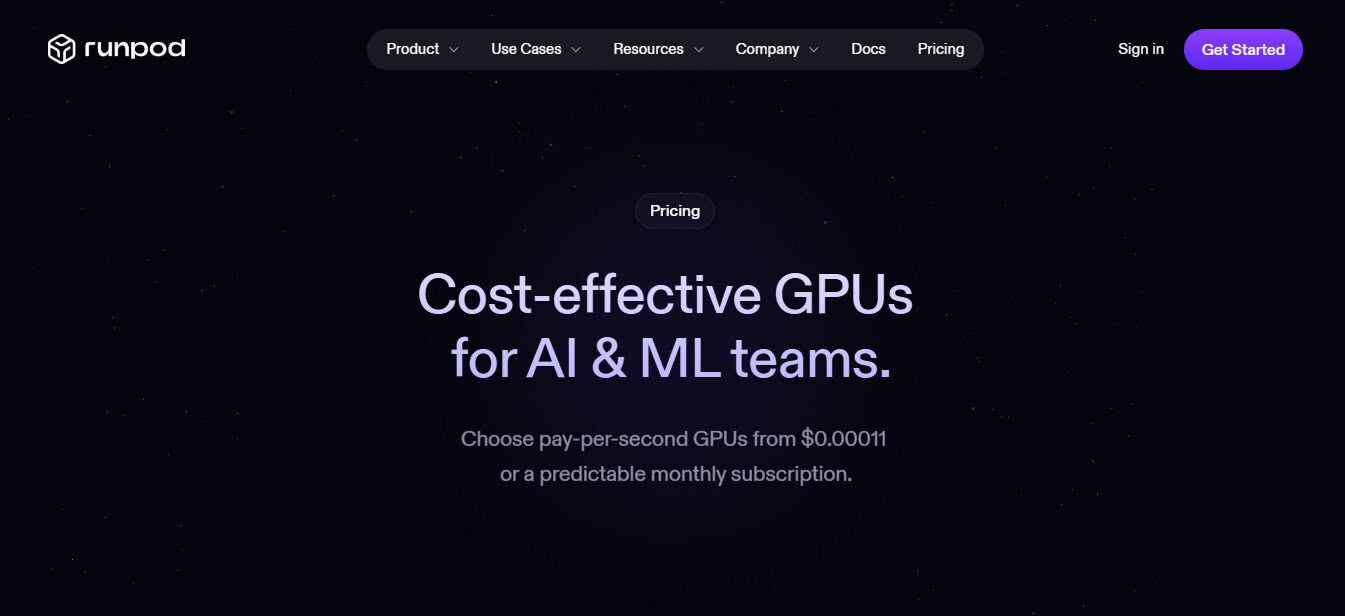Review: Runpod – The Cloud Built for AI

Runpod is rapidly emerging as one of the most innovative cloud platforms built specifically for artificial intelligence. In this comprehensive review, we dive deep into Runpod’s technology, pricing, features, and overall value proposition for developers, researchers, and enterprises who require scalable, on-demand GPU compute power without the hassles of traditional infrastructure management. This review will help you understand how Runpod can accelerate your AI experiments while reducing costs and complexity.
Overview of Runpod
Runpod positions itself as an all‐in‐one cloud platform that simplifies the processes of building, training, and deploying AI models. By providing on-demand cloud GPUs, serverless compute environments, and instant clusters, the platform eliminates cold starts, complex provisioning, and scaling headaches. With a robust global network, Runpod ensures low latency by hosting workloads in multiple regions. Its flexible pricing model billed by usage rather than by time, means you only pay for what you use – an attractive proposition for startups and enterprises alike.
At its core, Runpod is designed for developers who want to focus on their applications rather than worry about the underlying hardware. Whether you are fine-tuning large language models, performing inference for real-time applications, or running compute-heavy tasks like simulations and rendering, Runpod’s infrastructure adapts to your needs. The platform integrates modern orchestration tools, persistent storage solutions, and comprehensive monitoring capabilities to create an environment that is both scalable and secure.
Before we get into the details of its features, consider what makes Runpod stand out: its commitment to cost efficiency, simple user interface, and serverless model that supports active workers to minimize latency. The following sections will provide an in-depth look at its benefits, technological innovations, and pricing plans.
Key Features and Benefits
On-Demand Cloud GPUs and Serverless Compute
One of Runpod’s primary strengths is its provision of on-demand, GPU-powered computing resources. Developers can quickly deploy cloud GPUs across 31 global regions, ensuring that even latency-sensitive applications run smoothly. The serverless option provided by Runpod allows users to launch workloads instantly without needing extensive setup. This immediacy eliminates the long wait times traditionally associated with provisioning hardware resources.
Moreover, the serverless infrastructure is designed to scale dynamically in response to demand. This means that if your application suddenly experiences a spike in user activity, Runpod’s system automatically scales the number of GPU workers available without manual intervention, thereby maintaining performance and reliability.
Instant Clusters for Multi-Node Deployments
For complex projects that require parallel processing or distributed training, Runpod offers the ability to deploy instant clusters. This feature allows users to create multi-node GPU clusters within minutes, enabling highly efficient collaborative computing and reducing the time required to bring sophisticated models into production. The instant cluster feature is particularly useful for research teams and businesses that need to process large datasets quickly.
Cost Efficiency and Simplicity
Cost efficiency is a central focus of Runpod’s model. Traditional cloud computing services often involve high costs due to idle instances and long-term contracts. With Runpod, you pay for compute time in small increments, usually billed by the millisecond, which results in significant cost savings especially when workloads are variable. The transparent pricing structure allows businesses to forecast budgeting accurately and reduce waste.
In addition, the platform provides a simple and intuitive user interface that minimizes the steep learning curve associated with cloud deployments. Comprehensive dashboards help users monitor real-time performance metrics, usage, and system health, so that any potential issues can be detected and resolved without delay.
Enhanced Security and Global Reliability
Runpod is designed with security and reliability in mind. The platform uses advanced security protocols and is in the process of obtaining key industry certifications such as SOC2, HIPAA, and GDPR. For organizations handling sensitive data, this ensures that your intellectual property and user information remain protected. Furthermore, the geographically distributed data centers and failover systems guarantee high uptime and consistent performance, making Runpod a dependable choice for mission-critical applications.
Built-In Orchestration and Flexibility
Beyond raw compute power, Runpod provides built-in orchestration capabilities that simplify task distribution and management. This means that you can set up workflows without the need to build or integrate third-party orchestration systems. Developers have full control over GPU model configurations, scaling behaviors, idle time limits, and data center selections, which allows for a fully customizable cloud computing experience.
Promotions and Special Offers
Runpod frequently introduces promotional discounts and special offers aimed at encouraging new users to try their platform. These promotions often include trial credits, discounted rates for the first month, or bundled offers for startups and educational institutions. Remember to check their official website or subscribe to their newsletter to stay updated on the latest promotions. This built-in incentive structure not only makes the service more affordable but also reduces the risk for developers testing the service for the first time.
Plan Options
| Plan | Price | Features |
|---|---|---|
| Basic | $0.07 per GPU-hour | On-Demand Cloud GPUs, Basic Monitoring, Global Regions |
| Standard | $0.05 per GPU-hour | Serverless Compute, Instant Clusters, Enhanced Support |
| Enterprise | Custom Pricing | Dedicated Resources, Advanced Security, Full Orchestration, 99.9% Uptime Guarantee |
Technical Performance and User Experience
Speed and Efficiency
One of the most commonly reported benefits by users is the speed at which Runpod’s infrastructure can be deployed, resulting in sub-200ms cold-start times with their FlashBoot technology. This quick turnaround minimizes downtime and ensures that even highly volatile workloads are managed seamlessly. For developers who rely on rapid iteration and testing, this performance advantage is crucial.
User Dashboard and Monitoring Tools
The user dashboard is designed to provide real-time insights into system performance, GPU allocation, cost tracking, and overall resource usage. The interactive graphs and detailed logs empower users to quickly identify any issues and adjust parameters accordingly. The intuitive design of the dashboard makes it easy for both seasoned developers and newcomers to manage their projects.
Integration with Popular AI Frameworks
Runpod integrates well with leading AI frameworks such as TensorFlow and PyTorch, making it a versatile tool in a developer’s arsenal. The compatibility across different libraries and the seamless API integration streamline workflows, helping teams to transition from local development to production without complex adjustments or compatibility concerns.
Additionally, the platform provides extensive documentation and support resources, including a dedicated section for tutorials, FAQs, and community-driven forums. This commitment to user education ensures that clients can maximize the benefits of the platform quickly and effectively.
Pricing and Cost Comparison
Runpod’s pricing model is designed to be both competitive and flexible. Traditional cloud providers often charge a premium for GPU access, and many of them require long-term commitment contracts. Runpod, on the other hand, employs an on-demand pricing model that bills users only for the precise amount of computing power they utilize. This model significantly reduces the cost for sporadic workloads and during periods when high performance is not required.
A recent independent cost analysis compared Runpod against major cloud providers such as AWS, Azure, and GCP. The findings revealed that Runpod can deliver substantial savings – sometimes reducing infrastructure expenses by more than 50% – while offering similar if not superior performance for AI-specific tasks. This cost efficiency makes Runpod particularly attractive for startups and smaller enterprises with limited budgets and for large-scale operations seeking to optimize expenses.
Real-World Use Cases
Inference for AI Applications
Many businesses now rely on real-time inference to power features such as chatbots, recommendation engines, and content generation. Runpod is well-suited for these tasks because its low-latency infrastructure ensures quick response times even under heavy load. Companies using Runpod have reported smoother user experiences and lower operational costs as a direct result of the platform’s efficient scaling and on-demand resource allocation.
Model Training and Fine-Tuning
Another significant use case for Runpod is in the training and fine-tuning of AI models. Traditional training setups often involve long waiting times due to hardware provisioning and configuration. With Runpod, teams can spin up powerful GPU instances almost instantly, allowing for rapid experimentation and iterative improvement. Whether you are training a machine learning model from scratch or fine-tuning an existing model, Runpod’s infrastructure reduces downtime and speeds up development cycles.
Deploying Multi-Node Clusters
For enterprises that need to deploy large-scale, distributed AI models, the instant clusters feature of Runpod is a game changer. Multi-node clusters enable parallel processing across several GPUs, facilitating faster training on large datasets and enabling more complex computations. These clusters are particularly valuable in research environments where computational demands can change rapidly.
Customer Testimonials and Case Studies
Runpod is trusted by engineers and businesses across multiple industries. Customers consistently praise its fast deployment times, robust reliability, and significant cost savings. Case studies indicate that organizations have reduced their infrastructure bills by 90% by switching to Runpod’s flexible, serverless model. Additionally, many users report that the platform’s ease of use has allowed them to focus more on innovation rather than spending time on infrastructure management.
These testimonials reinforce the platform’s promise of “building the future, not infrastructure”, as Runpod continues to disrupt the conventional cloud computing market for AI.
Conclusion and Final Thoughts
In a landscape crowded with traditional cloud providers, Runpod stands out by offering a platform that is tailored for the specific needs of the AI community. Its on-demand GPU cloud computing, serverless infrastructure, and instant cluster features make it an ideal solution for developers looking to accelerate their AI projects while managing costs efficiently. Whether you are an independent developer experimenting with new ideas or a large enterprise deploying complex models at scale, Runpod provides the reliability, performance, and simplicity needed to innovate quickly.
The transparent pricing model, combined with significant cost savings compared to major competitors like AWS, Azure, and GCP, makes Runpod a compelling choice. The platform’s commitment to security and global reliability ensures that your data and applications are protected and available when you need them. Moreover, the built-in orchestration features and easy integration with popular AI frameworks further enhance its appeal.
Overall, if you are looking for a cloud solution that helps you focus on development and innovation rather than infrastructure management, Runpod is worth considering. Its robust feature set, cost-effective pricing, and superior performance have already won the trust of leading companies in the tech world, and it continues to push the boundaries of what’s possible in AI cloud computing.
This post may contain affiliate links and we may earn commissions. Learn more in our disclosure.


